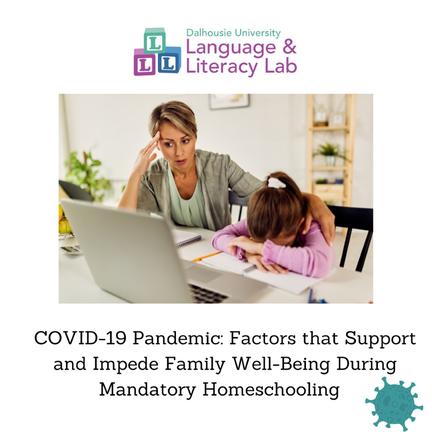Homeschooling and Reading Strategies
|
LEARN MORE ABOUT THE HOMESCHOOLING AND READING STRATEGIES STUDY |
WHAT IS THE STUDY ABOUT?
The COVID-19 pandemic has caused disruptions to work and family life like never before. For many parents, traditional care supports were suspended with no notice, leaving them to balance homeschooling their children while working from home, with varying degrees of support from education systems. The objective of this project is to examine how families functioned through this massive disruption.
Within this broader project, we took the opportunity to explore how these changes in education through the pandemic might impact how children read at home. Specifically, we are interested in whether there is a shift to reading in a digital form, over paper, and also how reading strategies might differ across these media. We test these questions within different educational contexts:
(1) those mandated to homeschool (i.e., schooled at home because of the COVID-19 pandemic),
(2) those homeschooling voluntarily (i.e., schooled at home for reasons unrelated to the COVID-19 pandemic), and
(3) those who are schooled in-person (i.e. attended in-person classes during the COVID-19 pandemic).
The COVID-19 pandemic has caused disruptions to work and family life like never before. For many parents, traditional care supports were suspended with no notice, leaving them to balance homeschooling their children while working from home, with varying degrees of support from education systems. The objective of this project is to examine how families functioned through this massive disruption.
Within this broader project, we took the opportunity to explore how these changes in education through the pandemic might impact how children read at home. Specifically, we are interested in whether there is a shift to reading in a digital form, over paper, and also how reading strategies might differ across these media. We test these questions within different educational contexts:
(1) those mandated to homeschool (i.e., schooled at home because of the COVID-19 pandemic),
(2) those homeschooling voluntarily (i.e., schooled at home for reasons unrelated to the COVID-19 pandemic), and
(3) those who are schooled in-person (i.e. attended in-person classes during the COVID-19 pandemic).
PROJECT HISTORY
To explore these questions we conducted a survey between March and May 2021. During this time, 962 couples were surveyed and asked to complete a set of questions on the type and frequency of paper and digital reading strategies (sounding out words, discussing prior knowledge of the topic, checking in on understanding, and encouraging recapping) reflecting on the time period between January 15 to February 15, 2021. Parents reported on their youngest child between Grades 1 and 5.
To explore these questions we conducted a survey between March and May 2021. During this time, 962 couples were surveyed and asked to complete a set of questions on the type and frequency of paper and digital reading strategies (sounding out words, discussing prior knowledge of the topic, checking in on understanding, and encouraging recapping) reflecting on the time period between January 15 to February 15, 2021. Parents reported on their youngest child between Grades 1 and 5.
WHAT HAVE WE FOUND SO FAR?
|
When comparing the use of reading strategies between paper and screen modalities, results indicated that both mandated homeschoolers and in-person learners employed reading strategies while reading on paper more frequently than while reading on a screen. No difference was found between modalities for voluntary homeschoolers.
|
|
In terms of checking in on understanding and encouraging recapping, mandated homeschoolers employed these strategies more frequently relative to voluntary homeschoolers with no difference between in-person learners and mandated homeschoolers. There was no significant interaction between strategy type, modality, and homeschooling group.
|
WHAT'S NEW?
Future planned analyses will examine whether these relationships vary with children’s age (e.g., early elementary 5-7 years old, middle elementary 8-12 years old).
Future planned analyses will examine whether these relationships vary with children’s age (e.g., early elementary 5-7 years old, middle elementary 8-12 years old).
QUESTIONS ABOUT THE STUDY
If you have any questions about our study, please contact Language and Literacy Lab manager Stef Hartlin at [email protected].
If you have any questions about our study, please contact Language and Literacy Lab manager Stef Hartlin at [email protected].
MEET THE HOMESCHOOLING AND READING STRATEGIES RESEARCH TEAM
This project is led by Dr. Hélène Deacon, Ensuring Full Literacy Co-Lead and Director of the Language and Literacy Lab and Dr. Sherry Stewart, Director of the Mood, Anxiety, and Addiction Co-morbidity Lab at Dalhousie University, along with Stef Hartlin (Project Manager), Dr. Klaudia Krenca (Postdoctoral Fellow), Mariam Elgendi (Graduate Student), and Sarah Dunphy (Undergraduate Student).
This project is led by Dr. Hélène Deacon, Ensuring Full Literacy Co-Lead and Director of the Language and Literacy Lab and Dr. Sherry Stewart, Director of the Mood, Anxiety, and Addiction Co-morbidity Lab at Dalhousie University, along with Stef Hartlin (Project Manager), Dr. Klaudia Krenca (Postdoctoral Fellow), Mariam Elgendi (Graduate Student), and Sarah Dunphy (Undergraduate Student).
|
|
THANK YOU TO OUR PARTNERS AND FUNDERS
Thank you to everyone who took part in our survey and to the community groups and organizations that helped us connect with a larger audience and to our funders. Our work would not be possible without your support!
Thank you to everyone who took part in our survey and to the community groups and organizations that helped us connect with a larger audience and to our funders. Our work would not be possible without your support!












